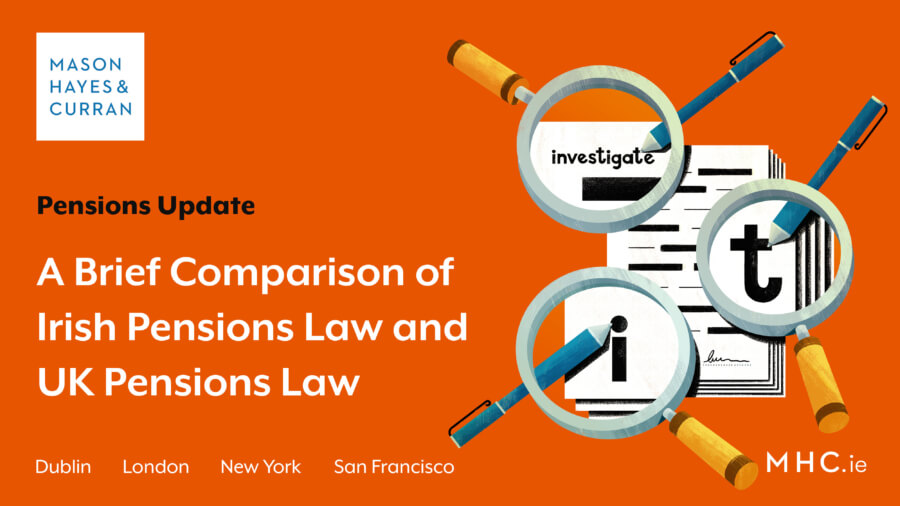
In this article, our Pensions
team compare the fundamental differences between pensions in Ireland and the UK.
In the past few years, we have seen the introduction of transformative legislation in both the UK and Ireland. In Ireland, we now have transposing regulations for the IORP II Directive (Directive). This event brings significant changes to the areas of pension scheme governance, trustee responsibility and qualifications and investment rules.
In the UK, the Pension Schemes Act 2021 is aimed mainly at defined benefit (DB) schemes and provides The Pensions Regulator (TPR) with significantly enhanced powers. We compare the state pension and group scheme landscape in both Ireland and the UK. We also look briefly at what might be in store for Irish pensions in the future.
The State Pension in the UK
The State Pension age in the UK is currently 66 and is set to increase to 67 later in this decade. The current rate is £185.15 per week but the amount actually received could depend on an individual’s National Insurance contributions record. A further increase in the State Pension age is planned, with 68 to be introduced as early as 2039. The UK Pensions Act 2014 provides for a regular review of the State Pension age at least once every five years.
The State Pension in Ireland
The Social Welfare Act 2020 deleted relevant legislation which would have increased the State Pension age to 67 from 2021 and to 68 from 2028. The Government confirmed in October 2022 that the State Pension age will remain at 66 though there will be an option from January 2024 to work until age 70 for a higher pension.; This goes against the advice of the newly established Commission on Pensions, which argued strongly in favour of incremental increases to the State Pension age over the coming years.
There is presently no legislation which will trigger a future increase in the State Pension age. New legislation will be required if any proposed increase is to take effect in the future.
For a person aged 66 and older, the contributory State Pension in Ireland is currently €253.30 per week and is paid to those who have made the required social insurance contributions. It is not means-tested, though it is taxable. However, an individual is very unlikely to pay tax where the State Pension is their only source of income.
Occupational pension schemes
Defined benefit schemes – UK
Members of DB schemes in the UK have a number of safety nets that are not available to their Irish counterparts.
Under section 75 of the Pensions Act 1995, as subsequently amended, participating employers become liable for what is known as a section 75 employer debt when they withdraw from a DB scheme. The debt owing by the employer is calculated on a buy-out basis. This calculation tests whether there are sufficient assets in a scheme at the time that the employer leaves to secure member benefits by purchasing annuity contracts from an insurance company.
In the UK, there is also a statutory fund called the Pension Protection Fund (PPF) which will pay compensation to members of eligible DB schemes where an employer has a qualifying insolvency event. The PPF was established in 2005 and over the years it has brought a number of DB schemes, linked to high profile corporate insolvencies, into its protection. Chief amongst these were the British Steel and BHS pension schemes.
Defined benefit schemes - Ireland
There is no such safety net for DB schemes in Ireland. It remains to be seen whether anything similar will be required. At the end of 2021, there were still over 490 defined benefit schemes subject to the funding standard. While the total number of DB schemes and their assets under management in the UK will always be much greater, Ireland has not been without its share of DB scheme controversies. As a result, the cost of maintaining DB schemes remains a significant concern for employers, especially during recessions.
Automatic enrolment and master trust schemes – UK
The UK implemented automatic enrolment (AE) in 2012. Since then, over 10 million workers have been automatically enrolled with over 1.6 million employers meeting their statutory duties. AE is thought to be well understood and has contributed to a higher level of awareness amongst workers of the importance of saving for retirement.
The introduction of AE in the UK also led to significant growth in its master trust industry. The UK master trust market grew to £16 billion assets under management by 2018. There are currently 90 providers providing master trust schemes to over 10 million members. TPR introduced a master trust Code of Practice in 2018 and all new master trusts must now be authorised with TPR.
Automatic enrolment and trust schemes - Ireland
There are currently over 8,000 stand-alone defined contribution (DC) schemes in Ireland with over 360,000 members. However, with the introduction of the European Union (Occupational Pension Schemes) Regulations 2021 (Regulations), the costs of maintaining small DC schemes have increased significantly. The increased costs and regulatory burden has already seen a significant growth in the master trusts industry in Ireland.
AE implementation is expected to be implemented in Ireland in 2024 with the Government approving draft heads of legislation in October 2022. The scheme will see some 750,000 workers enrolled automatically into a new workplace pension scheme with matching employer contributions and a state top-up. It will mean that all employees not already contributing to an existing pension scheme and who are aged between 23 and 60 and earning €20,000 or more across all employments, will be required to automatically enrol in the new scheme. The current expectation is that workers and their employers will initially pay 1.5 per cent of their gross salary into the scheme. From year four, that will increase to 3 per cent, rising again to 4.5 per cent in year 2030 and 6 per cent from 2033. The State will contribute €1 for every €3 paid in by the employee.
In its 2022 master trusts compliance report, the Pensions Authority also noted that while some issues remain, Irish master trusts are broadly compliant with the new regulatory requirements..
Conclusion
The UK's decision to leave the EU will continue to affect its pension industry. As Ireland continues to implement EU regulations aimed at harmonising pensions across the internal market, we are likely to see significant divergence in how pensions are regulated in the two jurisdictions in the years to come. However, the vast majority of pensions in Ireland and the UK will remain trust-based for the foreseeable future, meaning that it will always be possible to find similarities and learn from shared experiences.
For more information on the evolving pensions landscape in Ireland and how changes in provision might affect your organisation, contact a member of our Pensions team.
Common Questions
How much is the pension in the Republic of Ireland? The State Pension (Contributory) is €253.30 per week |
What will the UK State Pension be in 2023? It is expected to increase to £203.80 from April 2023 |
How much does a pensioner get a week in Ireland? €253.30 per week (contributory State Pension) |
How much is the non-contributory pension in Ireland? €237.00 per week |
Do you get State Pension if you haven't worked? Depending on your individual circumstances you may be entitled to the non-contributory State Pension |
How many years do I need for full State pension in Ireland? To qualify for a State Pension (Contributory) you must be aged 66 or over and have enough Class A, E, F, G, H, N or S social insurance contributions (PRSI). These are also called full-rate PRSI contributions. |
The content of this article is provided for information purposes only and does not constitute legal or other advice.








